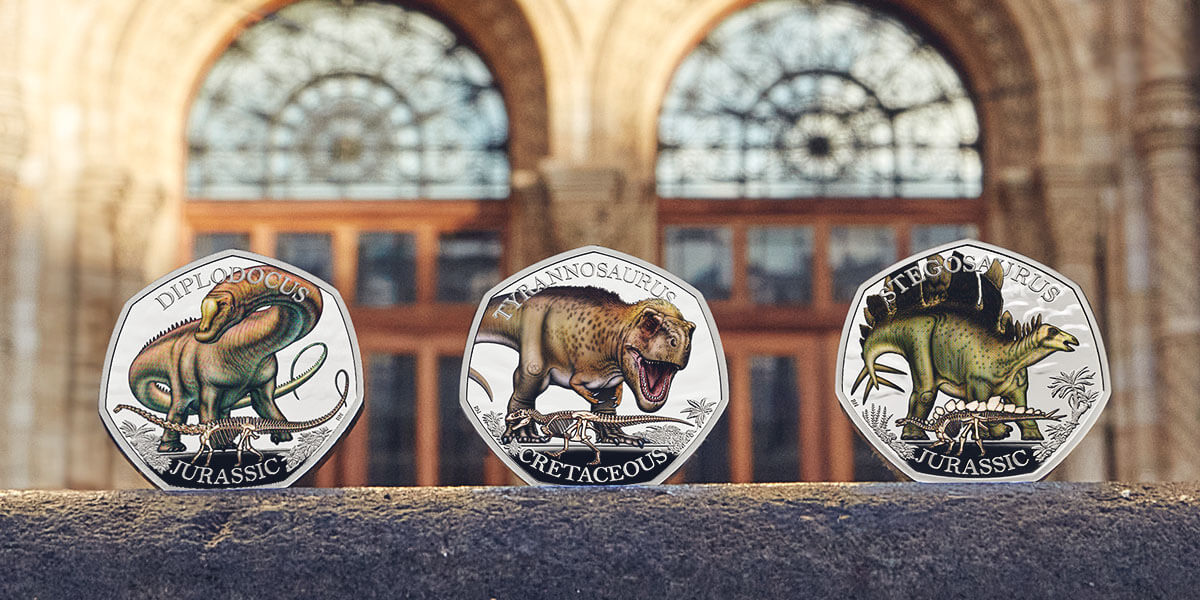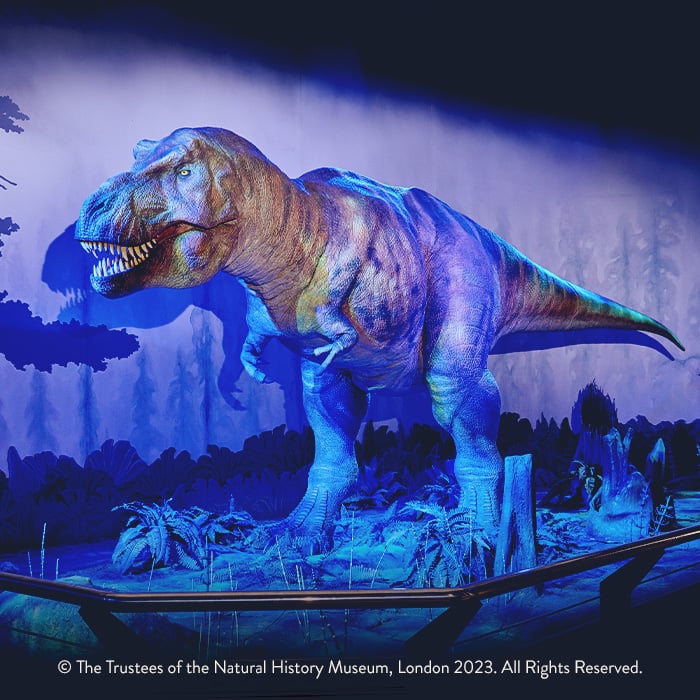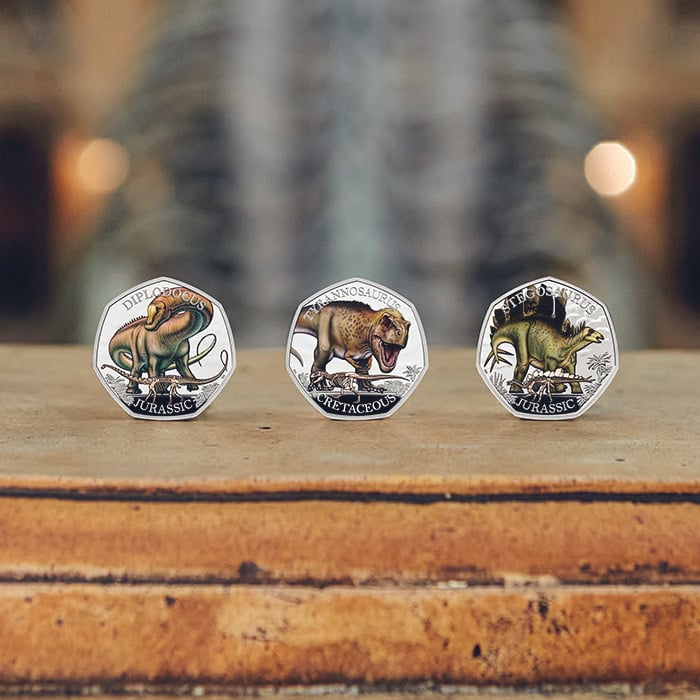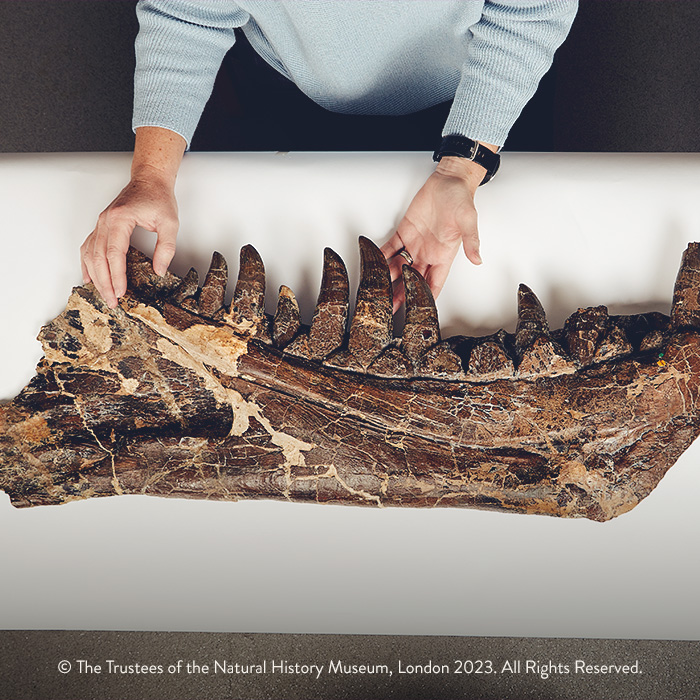Join us as we go behind the design of our three-coin Iconic Specimens collection dedicated to some of history’s most prominent dinosaurs.
Since our first dinosaur coin collection in 2020, The Royal Mint’s Tales of the Earth have captured the imagination of dinosaur enthusiasts both young and old. Naturally, as this collection continues to grow and expand, we are continuously looking to make this range bigger and better – and that has arguably never been more evident or literal than with our Iconic Specimens collection.
Featuring some of the most legendary dinosaurs of all time, the latest collection includes incredible artwork of the monstrous Tyrannosaurus, the hulking Stegosaurus and the gigantic Diplodocus. Much like our previous dinosaur collections, we once again turned to renowned palaeo-artist Robert Nicholls, the man behind the designs of both the Dinosauria and Mary Anning collections, for his artistic expertise.
So, without further ado, join us as we speak with the man himself and find out just how these incredible prehistoric designs came to be.
“These three dinosaurs are spectacular! Tyrannosaurus really is the most formidable land carnivore that has ever lived on our planet – ever! It is the most famous dinosaur for very good reasons. Meanwhile, Stegosaurus is not only immediately recognisable, but also bizarre! There is nothing like it on Earth today; those plates along its back and tail are an artist’s dream, and those spikes on its tail were a nightmare for its enemies.
“Finally, Diplodocus is not only a classic example of the unique sauropod body plan – enormous size, an extremely long neck and whiptail – it epitomises the special capabilities of the dinosaurs. The sauropod dinosaurs are the biggest animals to ever walk on Earth and some, like Diplodocus, could even stand up on their hind legs to feed 20 metres high in the canopy of trees.”
How did you approach the initial design process for each coin?
“The process required me to sketch in all the required features (species name, time period, skeleton, and feature image). I then repeatedly tweaked them until a successful composition was achieved; this was a complicated process for a variety of reasons.
“Firstly, the skeletons were very intricate structures and fitting them in a small place without interrupting other parts of the composition was challenging. Secondly, the extraordinary anatomy of each dinosaur made it difficult to fit them onto the coins. The long tails and necks, tall plates, and clawed feet etc. demanded a lot of attention. It was vital for the designs to remain anatomically accurate as well as attractive to collectors.”

Did you have a clear direction in mind before you started, or did the designs evolve over time as they progressed?
“There were some elements that carried over from the previous two coin collections, so I had a rough idea of where to start designing. However, not only did each of the uniquely shaped dinosaurs bring their own problems to solve, all three coins needed to work together as a set. Therefore, I found myself constantly altering the designs, often working on them at the same time, side by side, until they successfully worked together on my computer screen.”
How much research and preparation work went into each coin design?
“All my palaeo-reconstruction artworks require lots of preparation work. Except for birds, all dinosaurs are extinct. So, to resurrect them plausibly in art, I have to learn all I can about their anatomy via fossils, scientific papers and comparative anatomy (looking at the most closely related species). A serious palaeo-reconstruction artist must spend hours, days, even weeks studying their subject before starting an artwork.
“Basically, I build an extinct animal from the inside out. First, I look at the fossils and closely related species to reconstruct a skeleton. Next, I add on the soft tissues, such as the internal organs and muscles, and then the skin. Finally, I add on any spikes or plates etc. and then the colour patterns. We now have multiple dinosaur fossils that contain dinosaur colour pattern information, so the days of adding any colour one wants to a dinosaur have long gone.
“Dinosaurs appear to have used colour in the same ways that extant animals do, so we must learn about a dinosaur’s environment and add an appropriate colour pattern. Always remembering, of course, that most dinosaurs probably had full colour vision like birds today – there is so much to consider!”
How important was the input of Professor Paul Barrett from the Natural History Museum?
“It is essential for me to work with palaeontologists and follow their advice when creating my art. Brilliant experts, like Professor Paul Barrett, are able to help me keep my reconstructions scientifically up to date and realistic. Working with him and his colleagues at the Natural History Museum has been a career highlight for me!”
How was the overall experience providing the design for three of the most iconic dinosaurs in history?
“It was wonderful! I have dedicated my life to bringing extinct animals back to life through art. I started drawing dinosaurs as soon as I could hold a pencil – it is my obsession. Any project that allows me to work with long-dead animals is a joy, but having an opportunity to create collectable coins for The Royal Mint, with ministerial and royal approval, is very special indeed. Working on all three Tales of the Earth collections has been a thrill and an honour.”

What are your thoughts on the finished designs?
“I am very happy with them. They are unique and exciting but they also have some continuity with the previous two collections. I can’t wait to show them to the world – I hope everyone enjoys collecting them as much as I enjoyed designing them.”
If you could provide a future coin design for one dinosaur you have yet to cover, which dinosaur would it be?
“It would have to be Psittacosaurus. Psittacosaurus is one of the best-known dinosaurs in the world, and I have co-authored two scientific papers about this amazing dinosaur. Incredible fossils have enabled me to reconstruct this dinosaur so accurately that my Psittacosaurus reconstructions have been called the most accurate dinosaur reconstructions in the world.
“Not only have I been able to accurately build and paint the anatomy but also the melanin colour patterns in the skin! And these colour patterns have even informed us about the kind of environment Psittacosaurus lived in. Also, when my co-authors and I published a paper in 2021, I was the first person to accurately reconstruct and illustrate the anatomy of a dinosaur cloaca. I know every centimetre of this dinosaur!”
Sign up to the full three-coin collection to secure this incredible set and ensure you don't miss out on a single release. Each coin will be despatched as soon as possible upon launch and payment will automatically be taken when each coin is released.
![]()
![]()
![]()



